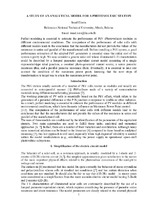| dc.contributor.author | Elzein, Imad A. | en |
| dc.coverage.spatial | Минск | ru |
| dc.date.accessioned | 2017-01-18T11:01:31Z | |
| dc.date.available | 2017-01-18T11:01:31Z | |
| dc.date.issued | 2016 | |
| dc.identifier.citation | Elzein, Imad. A study of an analytical model for a photovoltaic station / Imad Elzein // Информационные технологии в образовании, науке и производстве : IV Международная научно-техническая интернет-конференция, 18-19 ноября 2016 г. Секция Информационные технологии в производстве и научных исследованиях [Электронный ресурс]. – Минск : БНТУ, 2016. | en |
| dc.identifier.uri | https://rep.bntu.by/handle/data/27247 | |
| dc.description.abstract | Perfect modeling is essential to estimate the performance of PhV (Photovoltaic) modules in different environmental conditions. The comparison of the performance of solar cells with different models leads to the conclusion that the manufacturers did not provide the values of the resistance in series and parallel of the manufactured cell. Before installing a PhV system, a good performance estimation of the adopted PhV generators is essential since the initial cost of the system is pretty high. We may consider a generic solar cell whose illuminated I–V characteristics could be described by a lumped parameter equivalent circuit model consisting of a single exponential-type ideal junction, a constant photo-generated current source, a series parasitic resistance (Rs), and a parallel parasitic resistance (Rsh). Eventually, it is essential to take into account the condition of the maximum power point; knowing that the next steps of transformation to target was to attain the maximum power point. | en |
| dc.language.iso | en_US | ru |
| dc.publisher | БНТУ | ru |
| dc.title | A study of an analytical model for a photovoltaic station | en |
| dc.type | Working Paper | ru |

